Baltimore and Ohio Class D-30 Baggage/Dormitory/Coffee Shop car “Silver Spring”
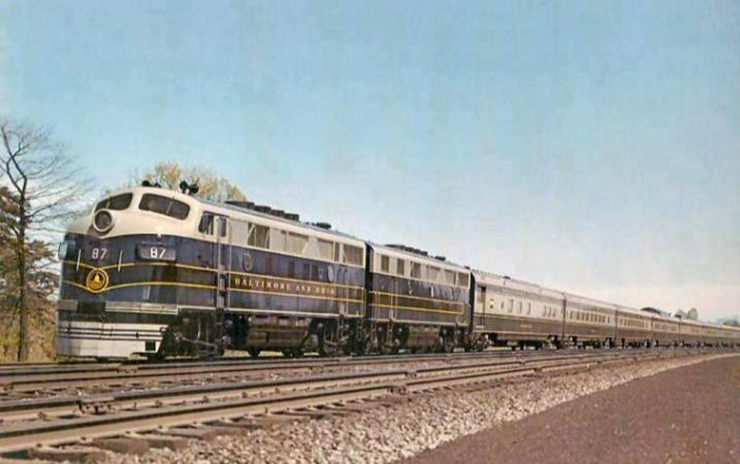 In May 1949, B&O took delivery of two eight car, lightweight, streamlined train sets from Pullman-Standard for the post-War reserved seat coach “Columbian.” They provided overnight service between Washington DC and Chicago. The above publicity photo shows one of the new “Columbian” trainsets on a tour of the B&O system before going into regular service. Each train carried a baggage/dormitory coffee shop, four coaches, a dome coach, diner and observation lounge, with the dome located mid-train. Both trains were originally powered with EMD F-3 units geared and equipped for passenger work.
In May 1949, B&O took delivery of two eight car, lightweight, streamlined train sets from Pullman-Standard for the post-War reserved seat coach “Columbian.” They provided overnight service between Washington DC and Chicago. The above publicity photo shows one of the new “Columbian” trainsets on a tour of the B&O system before going into regular service. Each train carried a baggage/dormitory coffee shop, four coaches, a dome coach, diner and observation lounge, with the dome located mid-train. Both trains were originally powered with EMD F-3 units geared and equipped for passenger work.
Recently, Sunset 3rd Rail/Golden Gate Depot imported their O scale B&O 1949 “Columbian,” offering it with correctly named cars in each trainset. The cars were made with extruded aluminum bodies, fully painted and lettered, with lighting, interior details and passengers. In the past, some of these cars were offered by American Lightweight as styrene kits. A few also were done in the 1980s with custom punched brass sides in kits with wood roofs and floors.
In this article, we look over building a B&O baggage/dormitory coffee shop car from a new Herkimer Tool/OK Engines custom made kit with an extruded aluminum body done with Kasiner dies from the late 1940s.
Kasiner began producing O scale streamlined passenger car kits in 1947, with extruded aluminum bodies having punched windows to suit various prototype cars. The first kits had smooth side bodies. By 1948, Kasiner added fluted side bodies with accurate Pullman Standard style corrugations. Each Kasiner full length O scale passenger car kit (with very few exceptions), had a prototype in service at the time.
Kasiner left the O scale market by the early 1950s and shortly afterward sold its HO passenger car kit line to OK Engines of Herkimer NY. About 12 years ago, Herkimer Tool/OK Engines began producing some O scale car kits by special order. They had the Kasiner dies for the O scale smooth side extruded bodies as well as a set of dies for Budd passenger car body extrusions.
Herkimer Tool/OK Engines has a library of prototype photos and drawings from which to refer in making custom orders. One of these was this kit for an O scale B&O Class D-30 baggage/dormitory coffee shop car.
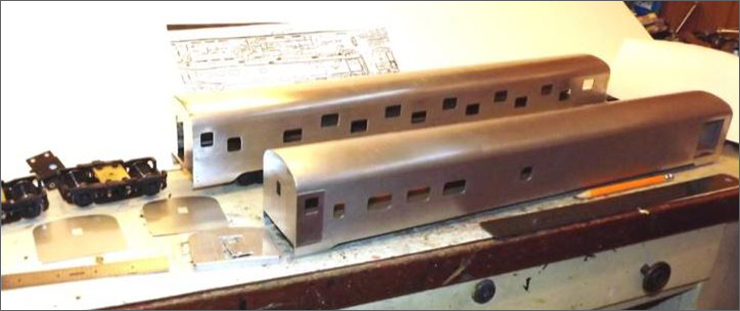 Out of the box and on to the work desk, the Herkimer Tool D-30 body stands beside a 1947 Kasiner Kit No. 2 for a 24 duplex roomette sleeper, whose “one off” prototype was built by Pullman in 1942. Both bodies have identical profiles. Kasiner did not cut out the vestibule side doors on smooth sided car, only those with fluted sides. Herkimer Tool cut out the vestibule doorways on their body and included the fold-up sheet aluminum doors Kasiner had with their fluted bodies.
Out of the box and on to the work desk, the Herkimer Tool D-30 body stands beside a 1947 Kasiner Kit No. 2 for a 24 duplex roomette sleeper, whose “one off” prototype was built by Pullman in 1942. Both bodies have identical profiles. Kasiner did not cut out the vestibule side doors on smooth sided car, only those with fluted sides. Herkimer Tool cut out the vestibule doorways on their body and included the fold-up sheet aluminum doors Kasiner had with their fluted bodies.
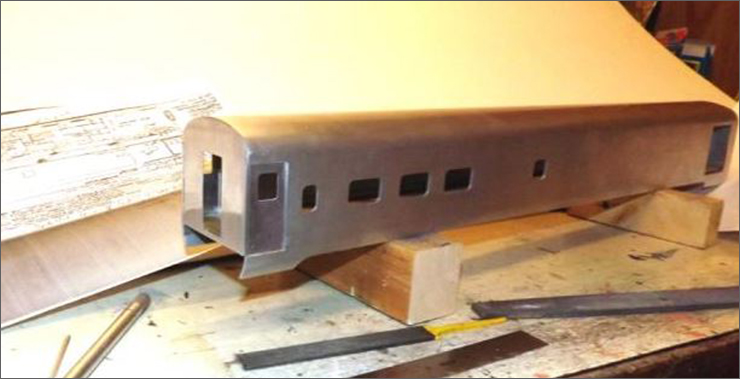 The sheet metal doors will be changed for much better detailed Delta Models vestibule doors. For some reason, Herkimer Tools window punch dies have too great a radius at the corners. It will take some file work, but it’s easily corrected.
The sheet metal doors will be changed for much better detailed Delta Models vestibule doors. For some reason, Herkimer Tools window punch dies have too great a radius at the corners. It will take some file work, but it’s easily corrected. 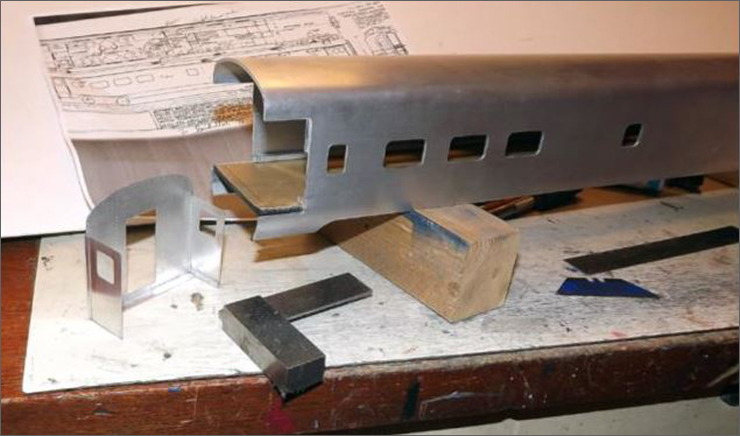
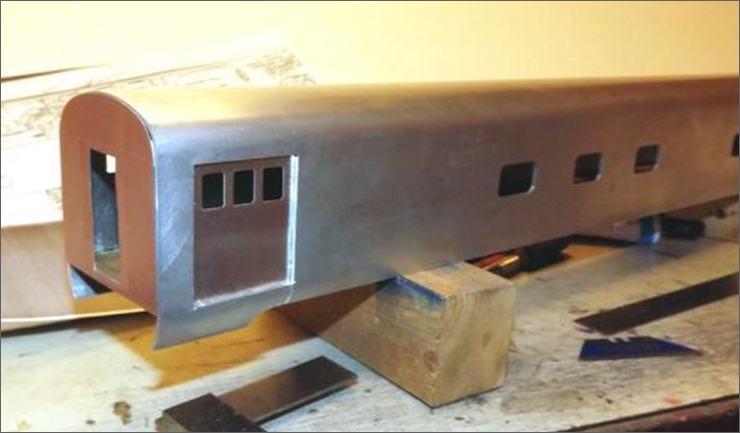 The aluminum sheet ends, the same as Kasiner had in the 1940s, were first given rivet impressions with a pounce wheel and straight edge before bending to fit under the floor. The stamped sheet aluminum baggage doors are also Kasiner-like but accurately done with three windows.
The aluminum sheet ends, the same as Kasiner had in the 1940s, were first given rivet impressions with a pounce wheel and straight edge before bending to fit under the floor. The stamped sheet aluminum baggage doors are also Kasiner-like but accurately done with three windows.
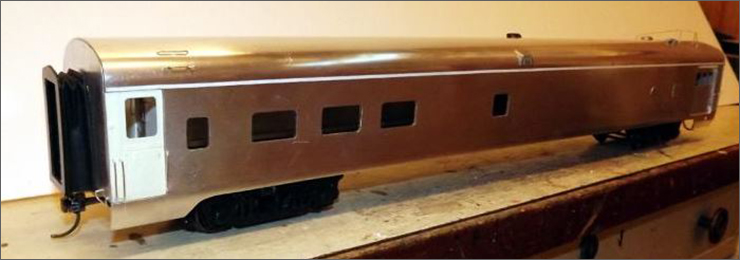 A pair of styrene doors by Delta Models have been installed, along with roof grab irons, handrails, ventilators and the ice breaker bar. A styrene strip has been added for the eaves seam, prominent on prototype cars. It also helps mark the roof to side eaves line for painting! The window corners have been tightened up by filing, to improve their appearance. The Golden Gate Depot trucks are fitted with specially made brass plate bolsters to provide a correct riding height for the car.
A pair of styrene doors by Delta Models have been installed, along with roof grab irons, handrails, ventilators and the ice breaker bar. A styrene strip has been added for the eaves seam, prominent on prototype cars. It also helps mark the roof to side eaves line for painting! The window corners have been tightened up by filing, to improve their appearance. The Golden Gate Depot trucks are fitted with specially made brass plate bolsters to provide a correct riding height for the car.
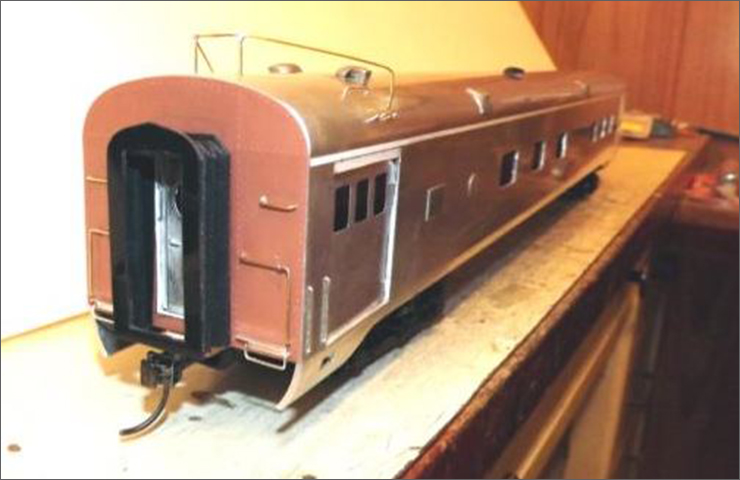 The icebreaker bar was made with .030”diameter brass rod. Important, with B&O’s tunnels and icicles forming in winter with the glass of the dome car trailing along! The rectangle and circle are plaques B&O put on these cars to advertise the name of the train with the company herald. A step has been cut into the skirt on each side, for the baggage doors.
The icebreaker bar was made with .030”diameter brass rod. Important, with B&O’s tunnels and icicles forming in winter with the glass of the dome car trailing along! The rectangle and circle are plaques B&O put on these cars to advertise the name of the train with the company herald. A step has been cut into the skirt on each side, for the baggage doors.
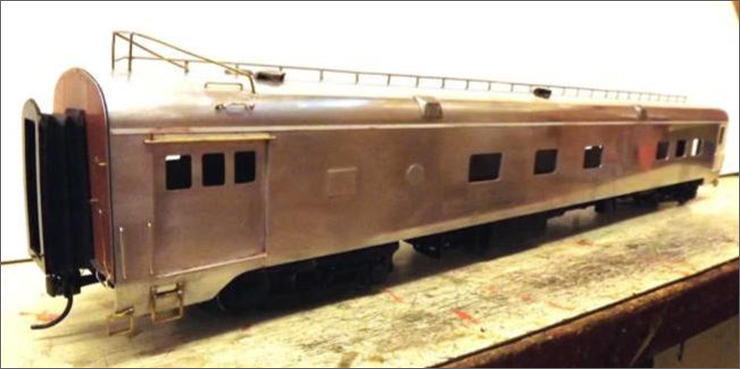 Final exterior details included the long radio antenna on the roof, made with .028” diameter brass rod and drilling a long line of many holes perfectly straight and evenly spaced. Corner stirrups and steps were made with .015” x 1/32” flat brass strip. These bodies build quickly. Before painting, the underbody and interior will be detailed. To follow the prototype closer, the baggage door header was lowered and a styrene strip inserted to match the sides. A rain gutter made with .025”diameter rod has been installed over it.
Final exterior details included the long radio antenna on the roof, made with .028” diameter brass rod and drilling a long line of many holes perfectly straight and evenly spaced. Corner stirrups and steps were made with .015” x 1/32” flat brass strip. These bodies build quickly. Before painting, the underbody and interior will be detailed. To follow the prototype closer, the baggage door header was lowered and a styrene strip inserted to match the sides. A rain gutter made with .025”diameter rod has been installed over it.
 The car floor by Herkimer Tool is a strip of phenolic plastic, very hard! It’s also a bit thinner than the Masonite floors Kasiner provided. A slightly deeper strip wood center sill eases that, as well as providing a mount for the 700 series long shank Kadee couplers. Golden Gate Depot trucks were provided by the kit’s owner. The other details were from Keil Line, along with some made of wood and styrene.
The car floor by Herkimer Tool is a strip of phenolic plastic, very hard! It’s also a bit thinner than the Masonite floors Kasiner provided. A slightly deeper strip wood center sill eases that, as well as providing a mount for the 700 series long shank Kadee couplers. Golden Gate Depot trucks were provided by the kit’s owner. The other details were from Keil Line, along with some made of wood and styrene.
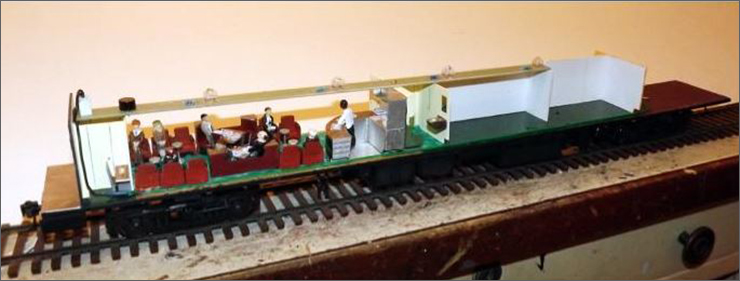 The interior is relatively simple. From left to right, a conductor’s office with his coffee cup still on the desk. Then the lounge area, with seats, tables and ashtray stands, along with the coffee bar. Behind that is the car attendant’s bedroom. The empty areas with walls are the dormitory rooms. No details here, as there are no windows! To the far right is the baggage room.
The interior is relatively simple. From left to right, a conductor’s office with his coffee cup still on the desk. Then the lounge area, with seats, tables and ashtray stands, along with the coffee bar. Behind that is the car attendant’s bedroom. The empty areas with walls are the dormitory rooms. No details here, as there are no windows! To the far right is the baggage room.
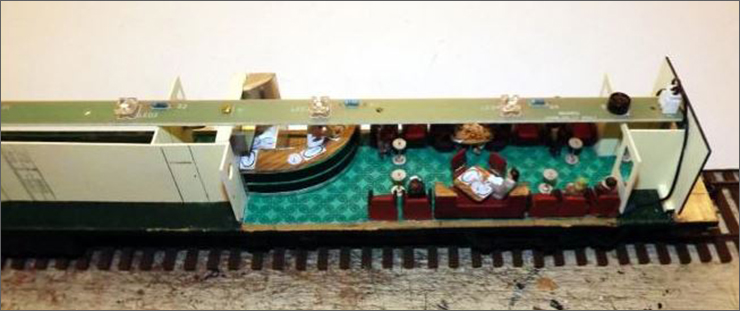 A clearer overview of the coffee shop. Cups are white beads, with B&O saucers punched from reduced size photos of B&O dining car china. Ditto for the place mats. The carpet is a fabric scrap. The LED lighting faces up, to the roof of the car. This was done on purpose, of course. The underside of the extruded aluminum body roof had been polished to a bright shine. This allows reflected light to more evenly illuminate the car’s interior. This method will also be used on other extruded aluminum body passenger cars.
A clearer overview of the coffee shop. Cups are white beads, with B&O saucers punched from reduced size photos of B&O dining car china. Ditto for the place mats. The carpet is a fabric scrap. The LED lighting faces up, to the roof of the car. This was done on purpose, of course. The underside of the extruded aluminum body roof had been polished to a bright shine. This allows reflected light to more evenly illuminate the car’s interior. This method will also be used on other extruded aluminum body passenger cars.
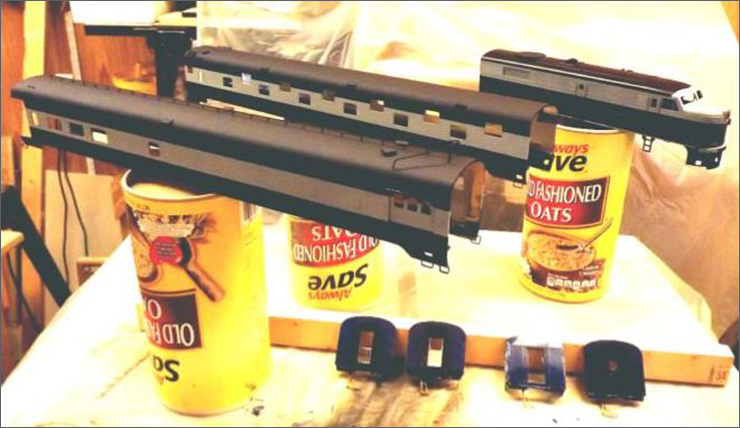 Scale Coat Royal Blue and B&O gray (by special order) have been applied to the D-30, along with two other B&O projects being worked on at the same time.
Scale Coat Royal Blue and B&O gray (by special order) have been applied to the D-30, along with two other B&O projects being worked on at the same time.
 Micro Scale B&O striping and lettering were applied. Micro Scale also had the only decals close to the B&O passenger car lettering font. Both Champ and Walthers missed the boat on this. But back in the 1950s – 60s, such was not quite as important to modelers as it is now.
Micro Scale B&O striping and lettering were applied. Micro Scale also had the only decals close to the B&O passenger car lettering font. Both Champ and Walthers missed the boat on this. But back in the 1950s – 60s, such was not quite as important to modelers as it is now.
 The finished Herkimer Tool B&O “Silver Spring,” ready for delivery to its owner.
The finished Herkimer Tool B&O “Silver Spring,” ready for delivery to its owner. 
Built by Edward F. Bommer February, 2015 with this photo Essay done July, 2016.















